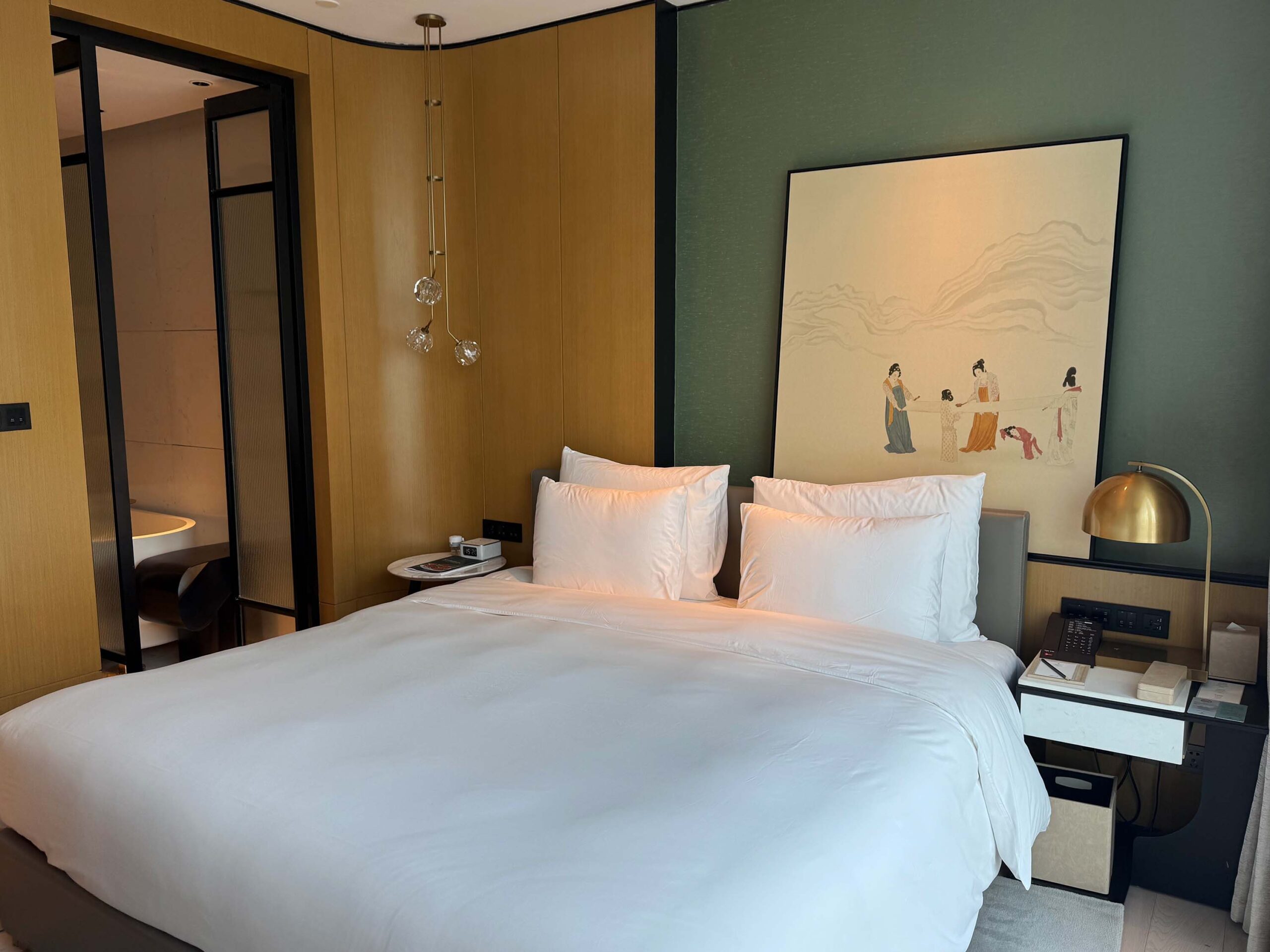
Kempinski Hotel Hangzhou
Nearest Airport : HGH (36 km away)
Neighbourhood : Gongshu District, Hangzhou
Website : kempinski.com
Address : 66 Lishui Rd, Hangzhou, Zhejiang, China, 310015
Chain : Kempinski
The Kempinski Hotel Hangzhou opened in 2019 as the German group’s 19th property in China, further cementing its presence in the country. Set within the modern Grand Canal Place development, the 344-room property became the first five-star hotel in the Grand Canal area. Designed by Singapore’s Avalon Collective, its debut also represented the first of a new generation of Kempinski Hotels – one that emphasises refined craftsmanship and the brand’s new ethos of ‘travelling in style’.
Booking the Kempinski
Having never researched Hangzhou before, I knew nothing about its hotel scene. Among its 5-star offerings, the city seems to split into two camps: ultra-luxury resorts clustered around West Lake catering to high-end tourists, and a different breed of upscale city-centre hotels geared towards business travellers. The Kempinski falls into the latter category, set in a newer urban pocket of Hangzhou’s otherwise historic downtown.

For my three-night stay at the Kempinski, I paid a nightly rate of CNY 1,020, equivalent to USD 142 or GBP 105. This booked me into an entry-level Deluxe King Room, without breakfast – or so I thought. I booked the hotel via Agoda.com, which was offering a negotiated rate with the hotel, at about 30% below the lowest available rate on virtually any other major website. Call that a win? Maybe.
Location
Located in Gongshu, the Kempinski Hotel Hangzhou sits in a modern business district shaped by Hangzhou’s role as China’s Silicon Valley. While the area isn’t especially touristy, the hotel overlooks the historic Grand Canal, with the Gongchen Bridge a half-hour walk away and the Xiangji Temple Historic Block nearby for artsy shops and gentrified spaces. Classic attractions like West Lake and Baoshi Hill are farther afield, and the nearest metro station is a 15-minute walk, though affordable Didi rides make the city easily accessible.

Check-in
After arriving from Shanghai on the excellent high-speed rail, I took a painless 25-minute DiDi ride from the city’s main station to the Kempinski Hotel Hangzhou. The moment the Grand Canal came into view, I knew we were close to the gleaming, modern property.


At the porte-cochere, a porter swiftly took my bags and directed me inside for check-in. The lobby left a strong first impression of being palatial yet contemporary. Although I don’t usually love marble walls, the designers somehow incorporated it succesfully into a sleek and modern lobby. It really struck a careful balance – stately without being outdated.


The modern design carried through to the reception area, where podium-style desks evoked something closer to an Andaz than a traditional Kempinski. They weren’t exaggerating about this being a new generation for the brand. At the ‘desk’, the duty manager greeted me by name and, in a refreshingly casual manner, completed the check-in alongside his colleague. To my surprise, my reservation included breakfast for one. Even better, I had been upgraded to a Junior Suite on the 7th floor.


With a pair of square wooden key cards in hand, I headed upstairs. Along the way, I noticed masks, infrared thermometers, and hand sanitiser outside several doors. Curious, I later learned that a company called Saint Bella partners with high-end hotels to provide post-partum care for new mothers. An unexpected sight! If I hadn’t known better, I might have mistaken the place for a quarantine facility.

Junior Suite
The gorgeous design was one of the biggest reasons I booked the Kempinski, and in this regard it didn’t disappoint. The Junior Suite I was assigned, measuring 53 sqm (570 sq ft), felt beautifully contemporary – warm and sleek without resorting into the drab, minimalist Japandi style so many hotels lean toward nowadays. In particularly, I loved the harmonious amalgamation of various elements and colours to compose a concise and tasteful space.


That balance came through beautifully in the living room, where soft blue and grey tones blended modern European design with elegant Chinese accents of golden brass and celadon green. I especially loved the painted glass screens on the walls, one of which could slide to hide the television and give the room a more classic feel. A discreet wooden sliding door also allowed the living area to be closed off from the bedroom, transforming it into a cosy and intimate space.

Beyond aesthetics, the living room proved practical and comfortable. A plush cloth sofa and modern armchair created a relaxed social setting, while the accompanying tables worked equally well as a desk. It was the perfect spot to enjoy a cup of TWG tea or freshly brewed drip coffee from the minibar, all while looking out over the central court of the Grand Canal Place shopping mall below. Although a Grand Canal view would’ve been nice, I certainly wasn’t one to complain!
Bedroom
Beyond the living room, the suite opens into the bedroom, which is divided into two zones – the sleeping area and an open walk-in closet. Just like the living room, the bedroom itself feels polished and comfortable, though a little tight around the edges. The design continues the suite’s refined style, with its curved wood and celadon-green walls, as well as a striking headboard backed by a modern interpretation of a traditional Chinese painting.


The king bed dominates the space and is easily its highlight. Dressed in plush linens, it was outstandingly comfortable, striking the perfect balance between firmness and support. I also appreciated the flexibility of the lighting, as the various lights and lamps could be controlled individually; this allowed for a personalised ambience customisation to suit any mood. Together, these small details made for a truly excellent night’s sleep.


Tucked neatly behind the television is the smart-looking open walk-in closet, complete with a built-in luggage rack. This was where the room’s design started showing questionable quirks. While stylish, it wasn’t the most practical space – storage felt limited having very few enclosed options. To make things worse, the drawers beneath the luggage rack were partially taken up by the safe. Overall, a rather questionable design choice, if you ask me.


Bathroom
Perpendicular to the bedroom sits the bathroom, a striking space defined by various marble and warm wooden elements. It’s separated from the bedroom by a pair of heavy black-iron French doors with textured frosted glass – a beautiful nod to Hangzhou’s ironsmithing tradition, despite being awkward in practice; with no proper handles, the doors proved surprisingly difficult to open and close, especially from the inside.


At its centre, a large vanity anchors the room, topped with an ornamental circular mirror framed in stylised wood. Beside it, a freestanding tub rests against the marble wall, a modern take on the classic claw-foot design. Golden brass accents appear throughout – particularly in the bathroom’s fixtures – adding polish and sophistication without being ostentatious.


Next to the tub is what can only be described as a ‘golden shower’ (and no, not that one). Clad in gleaming brass, the open shower nicely offers the luxury of both a rainfall and handheld head. Unfortunately, looks outpaced function, as the water pressure and temperature proved weak and inconsistent. At least the provided Natura Bissé toiletries was agreeable, with their pleasant scent and high-quality feel.


The toilet, housed in its own private room, completes the space. Clad in warm wood and marble, it features a plush TOTO Neorest, the kind you’ll find in Japan’s highest-end hotels. I’ve always loved these sumptous bidet-equipped toilets, and here it became, without question, my favourite feature of the bathroom.


Breakfast
Breakfast is served daily at Kitchen@K, the hotel’s all-day dining restaurant on Level 4 (07.00–10.00 on weekdays, until 10.30 on weekends). Despite the slightly cheesy name, the restaurant turned out to be excellent, offering one of the highest-quality and most comprehensive spreads I’ve seen at the hotel’s price point. The Art Deco-inspired dining room sets a refined backdrop for a wide range of Chinese, German, and Continental dishes, with much of the cooking done live at open stations.



Food
In addition to the typical fruit and salad bar, as well as the egg and noodle stations, the buffet featured items that felt distinctly Kempinski. Highlights included live cooking stations turning out German sausages, open-faced sandwiches, and freshly made Chinese pancakes, alongside a bain-marie spread of Hangzhou and regional Chinese dishes.




Another standout was the quality of the European-style cured meats, which were far better than what I’ve seen at most hotels in this category. It was clear that the emphasis wasn’t just on quantity, but also on quality.




As there are too many dishes to actually describe individually, I’ll mostly let the pictures show a visual guide to what you can expect for breakfast. Note that the selection does change daily, as it did during my three-night stay, although not to a drastic extent.














Beverages
Drinks were equally impressive. Alongside the usual juices and dairy, there were local touches like cold-pressed longjing tea, brewed herbal infusions, and even a range of plant-based milks, both hot and cold. I didn’t try the coffee, so I can’t say whether barista-made options were available.




Baked goods
At the far end of the restaurant was my personal favourite: the bakery section. Many hotels excel in cooked dishes but stumble on bread and pastries. Here, however, everything was fresh and well executed. One notable standout is the excellent pretzels – a fitting nod to the brand’s German heritage.








À la carte choices
Finally, there was also a small à la carte menu, though it seemed overshadowed by the vast buffet. On my last day, I tried the Eggs Benedict, which was just as satisfying as the rest of the spread. Between this and a similar experience at the Capitol Kempinski Singapore, I’d say the brand has a real knack for delivering memorable breakfasts!


Fitness Centre
The fitness centre is part of the Health Club and Kempinski Spa, accessed from Level 5, before a staircase leads down to its dedicated space on Level 4. Running along a corridor that links to the pool and changing rooms, it feels like a retreat within the hotel. Though tucked away, the gym is strikingly modern and chic – closer in style to an EDITION than the more traditional Kempinski aesthetic.


Far from the standard hotel workout room, the space is clad in warm wood tones that lend a refined, high-end atmosphere. Rows of sleek LifeFitness machines cover both cardio and strength training, complemented by free weights and even a proper power cage to match. Off to the side, a flexible studio serves as both a yoga and pilates room. The latter, in particular, is an impressive feature not often found in hotel gyms. What an unexpected wellness flourish!


Pool
Beyond a series of doors from the changing rooms – and after a quick foot bath – you’ll arrive at the hotel’s 25-metre heated indoor pool. While it may not be as dramatic as the promotional photos suggest, the space is sleek and modern, offering a calm setting that’s ideal for an early morning swim or a quiet retreat during the day.


A sculptural metallic ceiling ripples above the water, while rows of leather loungers line the pool’s edge, adding to the refined atmosphere. My favourite part, though, was the large jacuzzi at the far end, complete with sunken seats – a particularly relaxing touch where you could easily lose track of time. All in all, a very solid facility, and one I enjoyed more than I expected.


Shopping Mall
As mentioned earlier, the Kempinski Hotel is part of the Hangzhou Grand Canal Place shopping mall complex. Although the hotel isn’t physically attached, it sits right next door, making the mall an easy stop. There’s not a huge amount to see or do inside, though the selection of regional restaurants can be handy after a long day in the city. It also provides a sheltered, straightforward route to Daguan Road Station on Line 1.

Service
Service at the Kempinski Hotel Hangzhou is a bit hard to pin down. On the whole, staff were warm and approachable when engaged, often striking up casual conversation where language allowed. That said, English proficiency varied, sometimes even at reception or in the restaurants, which could make interactions uneven. While generally friendly, the service style wasn’t especially proactive – most staff didn’t go out of their way to greet or smile, and on occasion, a smile or greeting went unanswered.
There were also some inconsistencies in attentiveness. One fitness attendant, for example, smirked and rolled her eyes when I asked about borrowing a swim cap rather than purchasing one – an interaction I found dismissive, especially given that other hotels I stayed in had accommodated such requests. Fortunately, she proved to be an outlier, as every other attendant I met in the fitness centre was welcoming and helpful, even if communication wasn’t always easy due to the language barrier.
Overall
The Kempinski Hotel Hangzhou has many of the qualities of a perfect five-star urban hotel. Its rooms, facilities, and dining are outstanding, striking a fine and calculated balance between contemporary Western comfort and touches of Chinese flair. Yet a few aspects held it back from perfection – notably its less-than-ideal location, uneven service, and questionable quirks in room design. Still, it’s a property I’d gladly return to, provided I don’t decide to stay closer to downtown Hangzhou next time.


Leave a Reply